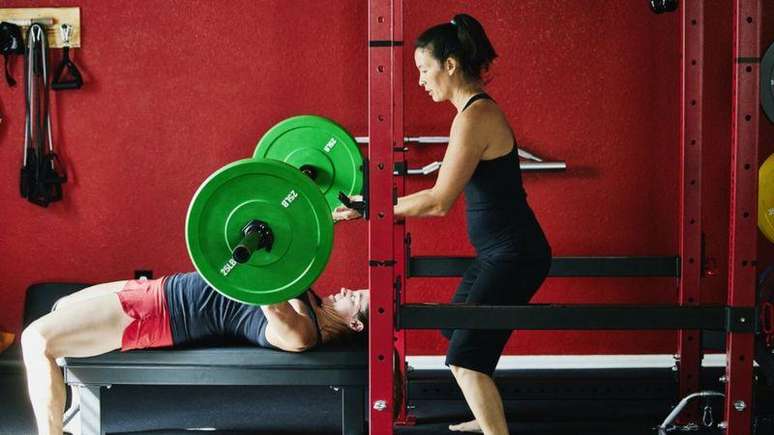Studies show that exercising one limb can also generate strength gains in the opposite limb.
Injured limbs need rest and are often kept in a sling or cast to immobilize them and aid in recovery.
However, several weeks later could mean smaller and weaker muscles. It takes a long time to rehabilitate these muscles, and muscle strength and function may not be fully restored for some people.
Experts are learning more and more about the “cross education” effect, whereby training one side of the body results in increased strength on the opposite side of the body. Our recent study shows that this can also prevent muscle atrophy in the “unused” arm.
So how can we exploit this effect?
First discovered a hundred years ago, the mechanisms underlying the cross-education effect are still not fully understood, but are likely associated with neural adaptations in the motor cortex of the brain that controls body movement.
The researchers reviewed nearly a hundred studies and showed that the average transfer rate between strength gains in trained muscle and untrained muscle ranged from 48% to 77%. So, if the strength of your trained arm increases by 20% after training the same muscle as your untrained arm, the strength of your untrained arm could increase by 10% even though you did nothing with it.
Such changes may be due to increased cortical excitability (the brain activity to control movement), decreased cortical inhibition (the signal to stop movements), decreased interhemispheric inhibition (the signals that direct movement instructions to one side of the body but not to the other), changes in voluntary activation or activation of new brain regions.

It appears that the type of muscle contraction during training influences the magnitude of the cross-training effect.
There are three types of muscle contractions:
– Isometric (static), where the force produced by a muscle is equal to the load on the muscle, such as holding a dumbbell;
– Concentric (shortening), where the force is greater than the load, such as lifting a dumbbell;
– Eccentric (stretching), where the force is less than the load, such as lowering a dumbbell.
Muscles can produce greater force during eccentric contractions than during isometric or concentric contractions. And less fatigue is induced during the eccentric than with other contractions.
Resistance exercises — when muscles work against a weight or force — increase muscle strength and endurance using these types of muscle contractions.
Several studies report that exercise consisting only of eccentric muscle contractions (for example, lowering a dumbbell but not lifting it) produces a greater cross-education effect than exercise consisting only of concentric contractions (lifting only) or concentric-eccentric contractions ( lifting and lowering). .
One study demonstrated that eccentric exercise training affected the cerebrospinal responses and stop signals (inhibition) of the untrained limb to a greater extent than concentric training.

In 2021, we compared eccentric and concentric resistance training for the cross-education effect, in which 18 young people (aged 20 to 23 years) performed progressive elbow flexor resistance training with one arm two times a week for five weeks using a dumbbell.
Both the eccentric (lengthening) and concentric (shortening) training groups increased muscle strength similarly after training (23 to 26%) for the trained arm. But the untrained arm showed a greater increase in strength after eccentric training (23%) than after concentric training (12%).
Transverse transfer rate (the correspondence between strength gains on both sides) was much higher (91%) for eccentric training when participants only lowered a dumbbell than for concentric training (49%) when they raised it .
This is in line with the result of our previous study, which showed greater strength gains and the cross-education effect of eccentric training.
Published in February, our most recent study involved 12 young men and showed how training one arm can prevent the other arm from weakening.
No workout caused a reduction in muscle strength and inactive arm size of up to 17%. Concentrated training reduced the loss to 4%. But eccentric training increased the strength of the locked arm by 4% and completely abolished the atrophy (loss of muscle mass).
Talk to a professional
These results support the recommendation of resistance training using eccentric movements or stretching of the nonimmobile limb to prevent muscle strength loss and atrophy in real injuries such as ligament sprains and tears or bone fractures and after surgery.
This type of training has not been widely used in rehabilitation so far. Further investigations into the mechanisms at play are needed, but our findings could lead to changes in the way rehabilitation is delivered.
If you have been injured and/or operated on and have an arm or leg immobilized, it is worth discussing with your doctor, surgeon or physiotherapist whether to exercise the corresponding limb on the unaffected side, especially with stretching movements against resistance or with the weight, it might be worth it.
*Professor of Exercise and Sports Sciences at Edith Cowan University (Australia)
This article was originally published on the academic news site The conversation and here republished under a Creative Commons license. Read the original version (in English) here.
Source: Terra
Rose James is a Gossipify movie and series reviewer known for her in-depth analysis and unique perspective on the latest releases. With a background in film studies, she provides engaging and informative reviews, and keeps readers up to date with industry trends and emerging talents.






